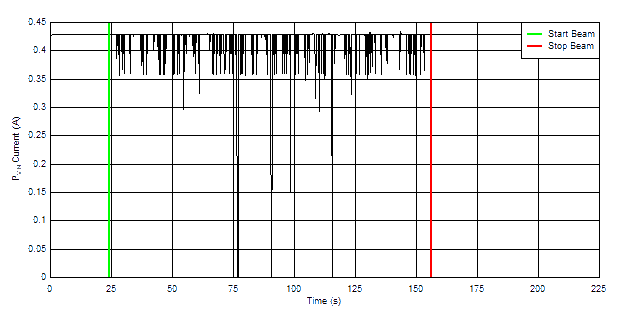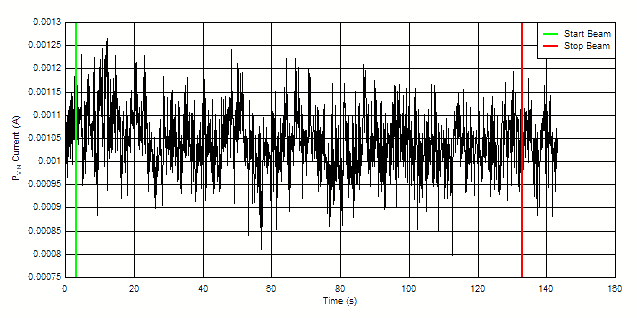SBOK044B December 2020 – December 2024 TPS7H4010-SEP
- 1
- 1 Abstract
- Trademarks
- 2 Introduction
- 3 Single-Event Effects (SEE)
- 4 Device and Test Board Information
- 5 Irradiation Facility and Setup
- 6 Depth, Range, and LETEFF Calculation
- 7 Test Setup and Procedures
- 8 Destructive Single-Event Effects (DSEE)
- 9 Single-Event Transients (SET)
- 10Event Rate Calculations
- 11Summary
- 12Revision History
- A Total Ionizing Dose from SEE Experiments
- B References
8.2 Single-Event Burnout (SEB) and Single-Event Gate Rupture (SEGR) Results
During the SEB/SEGR characterization, the device was cooled-down using a VORTEC tube (model: 611) to ≈10°C. The die temperature was monitored during the testing using a T-Type thermocouple attached to the thermal pad vias (on the bottom side of the EVM) with thermal paste. The thermocouple was held in place by using high temperature tape (kapton-tape). Die-to-thermocouple temperature was verified using a IR-camera.
The species used for the SEB/SEGR testing was a Krypton (84Kr) ion with an angle-of-incidence of 44.38°, degraded by 3-steps with a degrader angle of 47.75°, for an LETEFF = 43 MeV·cm2/mg (for more details refer to Section 6). The kinetic energy in the vacuum for this ion is 2.081 GeV (25-MeV/amu line). Flux of approximately 105 ions/cm2·s and a fluence of approximately 107 ions/cm2 were used for the four runs. Run duration to achieve this fluence was approximately 2 minutes. The two devices were powered up using the recommended maximum voltage of 32 V and the maximum load of 6 A. The TPS7H4010-SEP was tested under enabled and disabled modes, the device was disabled by using jumper J6 connecting EN to GND. The discrete load resistor was connected, even when the device was disabled, to help differentiate if an SET momentarily activated the device under the heavy-ion irradiation. During SEB/SEGR testing with the device "disabled," no VOUT transient or input current events were observed. No SEB/SEGR events were observed during all four runs, indicating that the TPS7H4010-SEP is SEB/SEGR-free up to LETEFF = 43 MeV·cm2/mg and across the full electrical specifications. Table 9-3 shows the SEB test conditions and results. Figure 8-2 shows a plot of the current vs time for run # 5 (Enabled) and Figure 8-3 for run # 6 (Disabled).
| RUN # | UNIT # | ION | LETEFF (MeV·cm2/mg) | FLUX (ions·cm2·s) | FLUENCE (# ions) | VOUT (V) | ENABLED STATUS |
|---|---|---|---|---|---|---|---|
| 5 | 5 | 84Kr | 43 | 1.05 x 105 | 1 x 107 | 1.8 | Enabled |
| 6 | 5 | 84Kr | 43 | 1.06 x 105 | 9.99 x 106 | 1.8 | Disabled |
| 7 | 6 | 84Kr | 43 | 1.12 x 105 | 9.95 x 106 | 3.3 | Enabled |
| 46 | 6 | 84Kr | 43 | 1.24 x 105 | 1 x 107 | 3.3 | Disabled |
Using the MFTF method described in Single-Event Effects (SEE) Confidence Interval Calculations application report and combining (or summing) the fluences of the four runs @ 10°C (3.06 × 107), the upper-bound cross-section (using a 95% confidence level) is calculated as:
σSEB ≤ 1.21 × 10–7 cm2/device for LETEFF = 43 MeV·cm2/mg and T = 10°C.
 Figure 8-2 Current vs Time for Run # 5 (Enabled) for the TPS7H4010-SEP at T = 10°C. The current spikes are due to the output transients on the output voltage.
Figure 8-2 Current vs Time for Run # 5 (Enabled) for the TPS7H4010-SEP at T = 10°C. The current spikes are due to the output transients on the output voltage. Figure 8-3 Current vs Time for Run # 6 (Disabled) for the TPS7H4010-SEP at T = 10°C
Figure 8-3 Current vs Time for Run # 6 (Disabled) for the TPS7H4010-SEP at T = 10°C